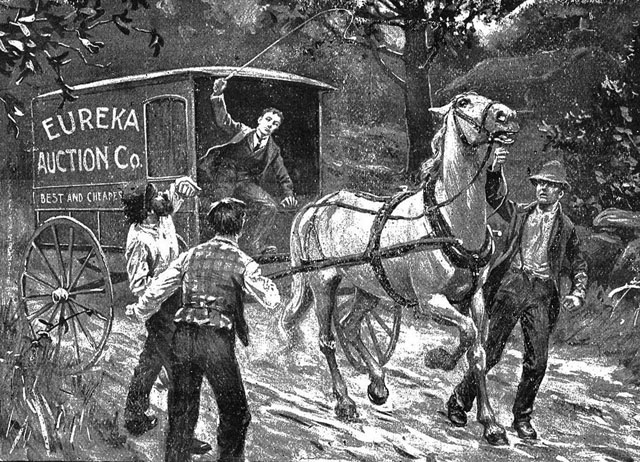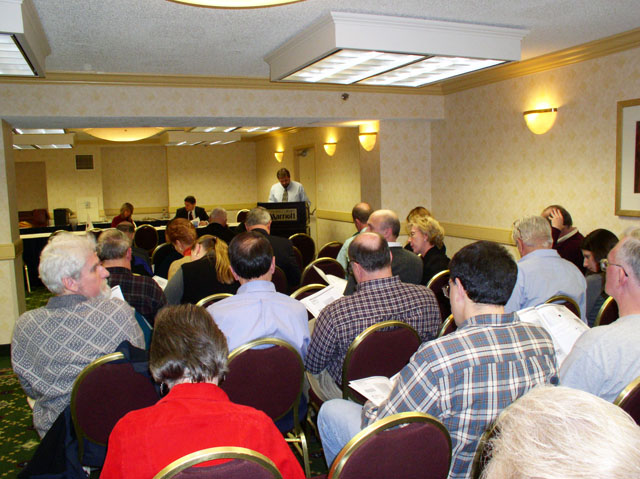Buying at auctions
Buying at live auctions is fun

Stratemeyer Syndicate, Public domain, via Wikimedia Commons
Auctions have been around for centuries and there are several different types. While the basic ideas are the same, different customs prevail in each. The various customs create a certain entertainment value which is why auctions have appeared so frequently in movies, sitcoms, and even thrillers.
That does not mean all those portrayals were entirely true. Some of those "little white lies" of the entertainment business have often left collectors with mis-conceptions. I get the idea that some of my correspondents remain unclear about the process. Some are intimidated by the speed of sales. I've had people complain they cannot understand auctioneers' peculiar chatter. Some people leave auctions wondering how they failed to win items they really wanted. Others leave wondering why they overpaid so drastically.
Experiencing a live auction
No matter how many times auctions have appeared in movies and on television, I have found that the majority of people have never experienced them personally. Before going to the first auction of stocks, bonds, coins, and other collectibles, I suggest participants attend a "normal" auction (if there is such a thing.) The easiest auctions to find, and they occur all the time, are estate auctions, antique auctions, and charity auctions. The latter is by far the slowest and least intimidating. Try an antique auction if antiques hold interest for you. You will always find something you want at an estate sale, even if it is a gag gift for an old friend. There are equipment auctions, starving artist auctions, livestock auctions, fine art auctions, race horse auctions, and auctions of fish just off boats. Numismatic auctions, and that includes scripophily, are somewhat different – and much, much quieter. Unlike the livestock or race horse auctions, you don't need to either dress up or dress down.
Auction myths
In conversations with collectors, I find a few common myths. Amateurs often think the balance of power is tilted against them as buyers. The truth is quite the opposite. No sales can take place until bidders buy. While bidders - theoretically! - can control their purchases, they often fall victim to their own emotions. That is why auctioneers in typical auctions try to keep emotions elevated.
I've heard several people ask, "What if I have an unbearable urge to scratch my ear?" Are you afraid you're going to bid by accident? It is an ultra-common myth because it happens every time on television. I've never seen it happen in real life. Auctioneers and their spotters have seen it all; they know what a bid looks like. In non-numismatic, non-scripophily auctions, a head nod or a head shake is usually adequate to make bidding intentions known. Auctioneers know how to make eye contact and they know who is serious about bidding and who is not. If anyone is still worried, don't look up.
Many collectors believe they cannot possibly win if dealers are going to be bidding. Not true! Yes, dealers attend most large auctions, but think about their business model for a moment.
Dealers need to profit from their purchases. That means they need to buy as cheaply as possible. Also remember, they are often unable to sell some items for years. If dealers think they might be able to sell a certificate for $300, they probably should not pay any more than about $130 to maybe $175 because they need to consider profit, holding costs, travel costs, and commissions. The might pay a little more if they have standing want lists from strong, established buyers, but they still need to make a profit. Collectors can usually out-bid dealers for single items. Dealers probably have an edge when it comes to winning multi-item lots.
Auction realities
In most sales I've attended, I've seen people bid against themselves. It is usually because bidders get over-charged on adrenaline and become more focused on other bidders than on themselves. When they do that, they broadcast their ultimate intentions of winning to the entire gallery.
When two "need-to-win" bidders go head to head, prices usually exceed reality.
Some people like to sit at the back of the room to try to hide their bidding activity from competitors. It is a common behavior and never really works. After a few winning bids, most participants know identities of winners, including Mr. Back-of-the-Room. One of the inevitable problems of trying to hide is that it is easy to lose track of current bids due to crowd noise and typical audience distractions.
Some people prefer to sit near the auctioneer in order to decrease distractions and to avoid missing bids. Additionally, auctioneers are more likely to notice subtle head nods and bidder numbers.
The importance of time

Auctioneer and participants at the Mario Boone (Centrum voor Scripophilie) auction and bourse held in Antwerp, Belgium, October, 2021
Image courtesy of Mario Boone
Time is money to auctioneers. Large auction houses may have tens of thousands to hundreds of thousands of dollars invested in catalogs, salaries, site rental, security, insurance, travel, advance payments and refreshments before sales ever take place. Auctioneers (including eBay) may sell only 15% to 40% of their lots. Large houses need to offer 2,000 to 3,000 items in order to recover costs and hopefully make profits.
Regardless of percentages of lots sold, every lot must pass under an auctioneers' gavel. That process takes time. Consequently, large auctions must sell lots at very fast paces. Many auctions of collectibles sell items at the rate of 100 to 150 lots per hour. (Or one lot every 24 to 36 seconds!) Buyers CANNOT sit on their hands if they want something! The pace of numismatic auctions are nothing like estate and antique auctions where auctioneers might struggle two or three minutes to sell a single lot.
Regardless of auction, pace of sale requires that participants stay alert. If bidders don't pay attention, they will find desired items sold without their participation. At estate and charitable auctions, bidders can often "drag their heels" and force auctioneers to lower starting bids. Such strategies rarely work in auctions of collectibles.
Participants' goals
Auctions are about money. Three groups of participants are involved in every auction and all are interested in money.
- Sellers want to sell their belongings for the most money possible.
- Auctioneers want to earn the highest possible commission in the shortest period of time.
- Buyers want to pay the least for the items they collect.
"Auctioneers' chant"

Jörg Benecke conducting a DWA auction (Deutsche Wertpapierauktionen GmbH) held in conjunction with FHW's shareholders' meeting and summer party at Wolfenbüttel, Germany, August 27, 2022
Image courtesy of Freunde Historische Wertpapiere
In typical sales, auctioneers use their voices to attract attention and keep participant's interest. Most use a sing-song style of calling bids that intersperses nonsensical sounds with real words. This chant is also known as "bid calling," "auction cry," "cattle rattle," and other terms. Whatever their style, the basic idea is for auctioneers to state the current price and ask for bids at the next higher increment, all the while trying to keep bidders from "going to sleep."
The best auctioneers tailor their chant for their audience. The worst auctioneers don't have a clue. One could reason that an audience composed of men in their sixties, seventies, and eighties probably holds an abundance of hearing aids. Fast chatter in such a situation is not going to win the auctioneer any favors – or good bids. More than once I have seen overly fast auctioneers removed during the sale because they mis-read their audience.
Fast auction chants are customary at cattle and livestock auctions. Rapid-fire chants are also customary at automobile auctions and even race horse auctions where bids can climb into the millions.
You will not hear over-amped auction chatter in expensive art auctions at Christie's and Sotheby's. Everything is low-key and sedate. Prices are clearly stated and bids are requested politely. Similarly, you (generally) won't hear auction chatter in better coin, currency, and certificate auctions.
In auctions of stocks, bonds and coins, auctioneers and bidders both tend to be very experienced. Sales usually take place in plain, clear language. It is quite common for coin and some certificate auctions to go something like this.
"Catalog number 1216. Opening bid 300 dollars. 400? 400? 350? 300? 300? Anyone? 1216 not sold."
"Next up is Lot 1217. We have a book bid for $450. 500. 600. 700. 800. 800? 800 dollars? I have two bids at 700. 750? I have a bid of 750 dollars. 800 once. 800 twice. Sold for 750 dollars to bidder number 174."
"Catalog number 1218..." etc.
This example would have taken about 45 seconds to work two lots. The offers would have proceeded at roughly the same pace if the auctioneer were dealing in thousands instead of hundreds of dollars. Item 1216 did not sell because it failed to meet a $300 minimum. but item 1217 sold for $750 in only a few seconds. Let's de-construct the sale of that lot.
After announcing lot number, "1217," the auctioneer told the participants that someone had submitted a mail bid for "$450." He then asked for a bid of $500 and four people held up their bidder cards. Next was an offer at "$600." Four cards remained in the air. At "$700," two cards dropped. At the "$800" offer, the remaining bidders dropped their cards. The auctioneer waved a couple of fingers at the audience and said, "I have two bids at 700." He then asked for a "$750" bid and one participant raised his card again. At that moment, the bid became $750. "800? 800 dollars?" was his second and third attempts to sell for $800, After no one raised their card again, the auctioneer nodded to the bidder who showed the card with his bidder number. A clerk made a notation on a tally sheet and the item was declared sold.
Sales can move quickly
Not every sale goes smoothly. There are always a few speed bumps and missteps. Still, sales progress quickly because most of the participants are experienced and know EXACTLY what they are willing to pay. Yes, adrenaline can flow and heart rates can rise, but emotions usually remain manageable. Everyone in the gallery is assumed to be a professional or at least act like a professional auction attendee.
Sale pace can also slow down
The higher the price of an item up for sale, the more time an auctioneer can spend trying to drive prices higher. If it takes a minute or even several to tease prices higher for a $10,000 item, an auctioneer might be netting $2,000 a minute. That would be a good use of time. Conversely, spending thirty seconds to sell a $25 item might be a waste of time.
The bidder "paddle"
While not necessarily true at every auction, most auctions require prospective bidders to register in advance. Participants usually give their name and credit card information and receive a "bidder's paddle" or more likely, a "bidder's card." That is what they hold up during the course of bidding. Ideally, numbers are large enough and written clearly so clerks can see to record winning bidders.
There are tricks to bidding

Fred Holabird selling a lot at the December, 2021 Holabird's Western Americana Auction held in Reno, Nevada
Image courtesy of Fred Holabird
Experienced bidders know their EXACT maximum bids before sales start. Ideally, they examine proposed purchases in advance. Sometimes, that step gets short-circuited by too much coffee before bidding starts. My wife and I consider it absolutely critical to know our EXACT top-dollar price before ever raising a bidder's card in a live auction. Our rule is, "no second guessing once bidding starts."
It doesn't matter what kind of auction you're attending. I don't care whether you're buying a milk can, a box of postcards, a piece of real estate or a top-flight collectible bond. If you do not know your EXACT maximum bid and stick with that value, you will be disappointed. You will either pay too much and regret it, or you will stop bidding too early and regret it. My wife and I suggest:
- Make a "cheat sheet" with your maximum bid amount. Write it in code if you don't want the person sitting nearby to see. Some people write those amounts in their auction catalogs if the auction house printed one.
- Determine your maximum bids long before sales start. A day or two beforehand is ideal. This is when your mind is clear and you are unaffected by adrenaline. The VERY WORST time to establish a maximum bid is after bidding starts.
- Factor buyers' commission, taxes and postage into your maximum bid.
The earlier you set your maximum bid, the better. Once your lot comes up for sale, and prices exceed your maximum value, you can drop out without remorse. If you win your lot below your maximum, you know exactly how happy to be. You will not overspend. You will be able to live with yourself. You will know you did the best you could.
The "Greater Fool" approach to auction bidding
This is the term I use for bidders who don't think about their upper limits before bidding
In live auctions, the "Greater Fool" reacts to other people's opinions of value. Someone raises a bid and "Greater Fool" responds. Another person bids and the "Greater Fool" responds. The "Greater Fool" looks around the room, trying to determine his competitors as if it is some sort of game. "How high will they go?" He doesn't know where bidding will stop. He just knows that he wants to be the last bidder. By his behavior, the "Greater Fool" tells everyone in the room his strategy – especially the auctioneer. The auctioneer has seen squadrons "Greater Fools" and knows how to extract the last dollar from them. It is true that the "Greater Fool" often wins his desired lots, but often at the cost of paying too much.
Although it sounds apocryphal, like scenes in movies, there are sometimes Provocateurs with well-stocked wallets who have the financial wherewithal occasionally drive up bids against "Greater Fools" just to watch them sweat. They know that "Greater Fool" is bidding out of a need to win, not a desire to acquire. With rare exception, they know when to pull out at the last minute and leave "Greater Fool" hanging out to dry.
"Auction fever" and "buyer's remorse"
I suspect, at one time or another, most bidders have played the role of "Greater Fool" and loathe the memory. I know I have. I thought I'd learned the lesson in the late 60s when I watched my dad get "auction fever" at an estate sale. He had told me all the rules, but nonetheless overpaid for a box of tools he really didn't need. After all this time, I still remember him moaning about his foolishness on the way home. And, of course, I've done the very same thing with books and engravings. (Want to see one of my Greater Fool moments? Check out the metal plate of the Utica Chenango & Susquehanna Valley Railway Co on my Project Purpose page. (Click "Definition of COLLECTIBLE")

Dealers and collectors at auction conducted by Scott Winslow & Associates in conjunction with the Bob Schell Stock Certificate and Bond Show, Herndon, Virginia, January, 2005
Image courtesy of Max Hensley
"Buyer's remorse" is painful and simple. If you don't know your maximum bid – and stick to it – you WILL suffer buyer's remorse, even if money is not the issue.
There is a less-discussed flip side. For the lack of a better term, the unwillingness to establish a maximum bid often results in "non-buyer's remorse." This is when the "Second Guesser" wants something, bids a couple times and then pulls out. "Second Guesser" has only one or two half-hearted competitors, so he wonders if they know something he doesn't. "Second Guesser" is unsure of value, gets cold feet, and loses a desired lot to someone who plays the game better.
My experience and observations force me to repeat the moral. Know your absolute maximum bids before bidding starts. Then stick to them. No matter how much you want something, don't raise your bid by even one dollar in the heat of bidding. If you pre-established values while you were thinking clearly, you can walk away knowing that YOU were neither the "Greater Fool" nor the "Second Guesser."
Read and fully understand "house" rules
Most stock and bond auction sellers issue catalogs, some physical, some online. Every auction house has different rules and customs. Never assume you know all the rules. Carefully read the catalog before the sale. Never assume that rules have not changed since a previous auction.
Auctioneers control sales
Regardless of published rules, auctioneers retain the right to modify rules to fit existing situations. Do not argue with auctioneers; you won't win.
Bid increments
In order to promote fast sales, auctioneers establish logical bid increments and remind participants before sales start. They may say something like, "Between $500 and $1,000, the acceptable bid increment is $100. Above $1,000, bids advance by $200. Once bids reach $3,000, we will advance in $500 increments." Bid increments generally appear in catalogs, but in-person auctioneer rules prevail.
"Cut" bids
In live auctions, auctioneers occasionally allow bidders to offer amounts smaller than normal increments. If bidding activity on an item stalls out, bidders sometimes offer amounts less than an auctioneer has asked for. Experienced auctioneers will generally stop sales at that point to explain house policies on "cut bids." For instance, auctioneers may say that they will accept one and only one cut bid per item. "If someone outbids the cut bid, then bids proceed at pre-established bid increments – no more exceptions!" Remember, auctioneers must keep coin, paper money, and certificate auctions moving along as quickly as possible.
For a reality check, think about the commission profit on a cut bid. If a cut bid would amount to $25 and the buyer's commission rate is 20%, then allowing a cut bid nets the auction house a mere $5.00 (plus an unknown seller's commission.) Simply put, it is probably not worth $6 or $7 to an auctioneer to slow down an auction if he has 900 more lots to sell. It is a completely different story if an auctioneer is selling forty items donated for a charity event.
Combined auction types
Major auctions normally combine mail bids, fax bids, phone bids and internet bids with live auctions. If you cannot attend, then definitely submit remote bids. These days, most major houses combine online bidding with their other methods. You must sign up in advance if you plan on submitting bids online. Online bidding often incurs additional commission charges to the company that handles the electronic portion of the sale.
If you do not have a fast internet connection, you might consider avoiding live online bidding unless the auction house uses time limits. Some auctions wait a specific interval of time (2 to 5 minutes) after the previous high bid before "hammering" sales closed. This gives every participant a chance to raise their bids without worrying about slow connection speeds.

Typical gavel used in auctions. This one is used to conduct business at the Utah House of Representatives, image via Wikimedia Commons
Estimated prices
Most auction houses estimate sales prices in low/high price ranges. Read the catalog rules to see if those price ranges relate to minimum acceptable bids.
Minimum bids
It is the current custom for auction houses to publish or announce minimum starting bid amounts. Some live auctions will lower those minimums during a live event to insure that as many lots as possible get sold. Never count on that, however.
Mail bids in competition with floor bids
Many collectors think they will be disadvantaged if they submit mail bids for auctions with live sessions. While it depends on the house, when lots attract equal floor and mail bids, mail bidders normally win. Some houses also split the difference if mail bids are substantially higher than floor bids. While the mail bid will win, the official hammer price may be only one increment higher than the floor bid. Examine house rules.
Reserve amounts
Sellers often ask auction houses to not sell expensive items unless they surpass certain amounts. In other words, sellers "reserve" items that fail to sell at acceptable levels.
Reserve amounts are always kept secret. Experienced auction houses try to make sure that reserve amounts are reasonable, but sellers sometimes insist on absurdly high minimums. Do not be disappointed when your bid fails to exceed reserve amounts. Just like you can never know the motivations of your bidding competitors, you will never know what sellers might be thinking.
Phone bidding
If you are interested in bidding on expensive items and you cannot attend live auctions, you should consider phone bidding. Large auction houses may dedicate several people to phone bids. Make arrangements well in advance of the sale. During the auction, your auction house representative will call you a few minutes before your target lots come up for sale. Your representative will help you bid just as if you were there in person.
Commissions
Houses charge buyers' commissions based on the amount of winning bids on each lot. Typical commissions are now running between 20% and 25%, but be sure to confirm with the auction catalog or auctioneer. Stepped commissions are also common. In those cases, houses charge one rate for bids up to a certain amount and then then a lower rate for bids above that amount. Again, confirm before establishing your maximum bids.
Taxes, packaging and postage
If you participate in person and take possession of items at auction sites, you will need to pay sales taxes or valued added taxes (VAT) applicable to the location where the sale was held. Depending on city, county, state, and country regulations, you may be able to avoid some or all taxes by having the auction company ship your winnings. In that case, you will need to balance your tax savings against postage and packaging costs and the difficulty of protecting your purchases during your travels. Check with the auction company. In either case, make sure you factor your total acquisition costs into your maximum bids.
Viewing lots

Participants viewing auction lots prior to
August, 2022 DWA auction
Image courtesy of Freunde Historische Wertpapiere
When you attend live auctions, make sure to view all lots that interest you before bidding starts. Do not rely on catalog photos and descriptions alone. This advice is particularly important when interested in lots containing several items. When bidding by mail, you want to make sure you understand auction house rules for returning items that are mis-described.
Applicable laws and jurisdictions
Every major auction house will specify the laws that will prevail in the eventuality of disagreements. Generally, prevailing laws are those of the location where the auction takes place. While auction companies state this provision for their own protection, do not bid if you distrust an auction house.
Review your financial circumstances before bidding
I am extremely serious about this. While unlikely, it is always possible you may win all lots you bid on. This happens more often than you might think, so make sure you can pay for all your winnings before you bid. It will be terribly embarrassing if that happens at a live auction.
Shill bidding
Inexperienced bidders frequently ask me about the prevalence of shill bidding. That is when a person participates in bidding simply to drive prices higher. Higher bids obviously result in greater income for the seller and higher commissions for the auctioneer.
While shill bidding can and does happen, the risks of encountering it in stock and bond auctions is very low. State laws enacted in the United States against the practice are very specific and penalties are severe. I cannot give advice on how to approach this subject relative to auction houses other than to suggest calculating how much a house could hope to benefit from shill bidding. If a shill bidder were able to increase the price of a $1,000 item by $500, the house might benefit by $100 at a 20% commission rate. Compare that to the threat of a $1,000,000 fine (in New York) if caught. The downside of getting caught shill bidding is very expensive.
Shill bidding In a typical scripophily or numismatic auction is borderline stupid. Almost all participants are familiar with each other. Inserting shill bidders into those situations is possible, but generally recognizable by both bidders and auctioneers. Professional participants are normally astute observers and cannot let shill bidding continue. Auctioneers will stop shill bidding in a heartbeat if they suspect one or more participants are attempting to manipulate prices.
Recent traffic on the internet strongly suggests shill bidding in online auctions is a genuine concern, although not focused on a microscopic market segment like scripophily. If at all concerned about shill bidding, I strongly recommend that collectors research the subject online.
Remember, you can protect yourself against most of these eventualities by simply establishing the maximum amounts YOU are willing to pay. Who cares what someone else might be willing to pay?
Bid increments
In typical auctions of collectibles, auctioneers advance bids by fixed amounts equal to roughly 2% to 10% of current bid prices. Here are typical bid increments that were in effect in mid-2022. Oddly, some auction houses do NOT publish their increments.
These charts are for illustration purposes only and may change between now and the time you read this. Other auction houses will use similar, but different increments. Also remember that auctioneers reserve the right to modify increments for particular situations. Auctioneers will sometimes alter bid increments to force quicker sales or promote more gallery participation.
Archives International Auctions
| Current bid |
Bid increment |
| $0 - $100 |
$5 |
| $100 - $300 |
$10 |
| $300 - $750 |
$25 |
| $750 - $1,500 |
$50 |
| $1,500 - $3,000 |
$100 |
| $3,000 - $7,500 |
$250 |
| $7,500 - $15,000 |
$500 |
| $15,000 - $30,000 |
$1,000 |
| $30,000 - $75,000 |
$2,500 |
| $75,000 plus |
auctioneer's discretion |
|
eBay (US
| Current bid |
Bid increment |
| $0.01 - $0.99 |
$0.05 |
| $1.00 - $4.99 |
$0.25 |
| $5.00 - $24.99 |
$0.50 |
| $25.00 - $99.99 |
$1.00 |
| $100.00 - $249.99 |
$2.50 |
| $250.00 - $499.99 |
$5 |
| $500.00 - $999.99 |
$10 |
| $1,000.00 - $2,499.99 |
$25 |
| $2,500.00 - $4,999.99 |
$50 |
| $5,000 plus |
$100 |
|
Mario Boone
| Current bid |
Bid increment |
| €10 - €50 |
€5 |
| €50 - €200 |
€10 |
| €200 - €500 |
€20 |
| €500 - €1,000 |
€50 |
| €1,000 - €2,000 |
€100 |
| €2,000 - €5,000 |
€200 |
| €5,000 - €10,000 |
€500 |
| €10,000 - €20,000 |
€1,000 |
| €20,000 plus |
€2,000 |
|
Holabird Western Americana
| Current bid |
Bid increment |
| $1 - $95 |
$5 |
| $100 - $190 |
$10 |
| $200 - $475 |
$25 |
| $500- $1,450 |
$50 |
| $1,500 - $3,400 |
$100 |
| $3,500 - $9,750 |
$250 |
| $10,000 - $29,500 |
$500 |
| $30,000 plus |
$1,000 |
|